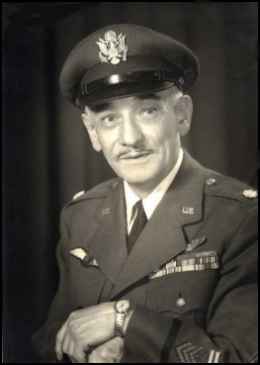
1886-1956 |
 |
Lt. Col. Ivan Lamb Taken in 1953/54 at Davis Monthan AFB Contributed by Harry Fanning, 10-11-10 |
|
via email from Peter Breen - September 26, 2003 However on re-reading Lamb's 'autobiography' Incurable Filibuster (published 1934 and still available in second-hand bookstores), I find the incident either never happened or had to have happened in November, 1914. Either way the incident throws Lamb's life out of whack for the following six years. How reputable historians have missed it I have no idea. But Dean Lamb's part in 'the first air duel' could not have happened, at least the way he described it. I have put the Lamb 'biography' to one side until I can verify his life. I have in the following details tried to sort out fiction from fact and those parts of his life that I have verified.. |
|
by PETER BREEN Chapter 1. Introduction, The War Years - 1886-1923 Chapter 2. Adventures in Brazil 1923-1924- Chapter 3. Return to the United States - 1924-1956 |
|
Reports On EB Flights During Revolution by Ernest Jones "Some members of the EB clan occasionally meet up with Dean Ivan Lamb, of the Lamb-Rader match." "It seems, according to Lamb, that he was flying a Curtiss for the Carranzistas under Benjamin Hill. Phil Rader was handling a Cristofferson for the other side." courtesy of Steve Remington - CollectAir |
|
|
|
|
|
1914-1915 DOCTOR LAWRENCE D. TAYLOR Excerpt of introductory paragraph. For the benefit of those of my visitors who don't read Spanish, I have translated this introduction. "The Mexican REVOLUTIONARY FIGHT from 1910 to 1920 constituted one of the first wars of this century in which the airplane was used as a battle weapon. The Italian Army was first to use the airplane, as well as the dirigible, in warlike conflicts during its conquest of the Turkish territory of Cirenaica and Tripolitania between 1911 and 1912. They were also used by the belligerent forces that fought in the War of the Balkan Mountains from 1912 to 1913." I am sorry that I can't find an English version of this story, because it is absolutely fascinating. It refers to many of the pioneers who took part in the fight including Dean Lamb, Didier Masson, Gustavo Salinas Camiña, Glenn H. Curtiss, Edwin Charles Parsons, Unfortunately, if you try to get an English translation using Babel Fish, you will only see about the first quarter of the article is translated. This doesn't reach the portion which deals with the activites of the American aviators. Unless you read Spanish, you will have to find the section, using the FIND button, copy it and paste it into the Babel Fish program. A lot of work... |
|
The sequel to the history-making events at Guaymas is as interesting as the bombing attempts themselves. Before the summer of 1913 was over, another first for military aviation took place in Mexico when two American mercenaries engaged in what might have been the first dogfight in history. Fought with revolvers, this engagement pitted Dean Lamb, flying for the revolutionaries in a Curtiss pusher, against Phil Rader, flying for the Federal government in a Christofferson. Both planes were similar to the Martin flown by Didier Masson, but the fliers were even more exposed in that both of those aircraft lacked a stabilizer or rudder in front of the pilot. The duel took place near the town of Naco and ended in a draw, with neither pilot gaining any advantage over the other. Editor's Note: This reference was found in the article titled Pioneering Air-Sea Engagement which was found on the website of the Aviation History Magazine. (7-15-02). Unfortunately it has disappeared from the internet. |
|
Born at Cherry Flats, Pa. in 1886, he was educated at Columbia University, various foreign military schools and the USAAF Intelligence School. His later military service was most extensive. Dean joined the old Curtiss flying school at Hammondsport, N.. in 1912, and later became an air mail pilot. During the civil war in Paraguay, 1922-23, he commanded the Paraguay air force against the revolutionists. He also was active in various other Latin American countries. He was president of the Bettis flying school at McKeesport, Pa., 1926-27; pilot-salesman for Air Associates, 1927-28; test pilot for Vertoplane Corp., New York, 1935-36; and president of Larga Company, aircraft export firm, 1938-39. His military record included service in the British Expeditionary Force in World War I; and service in the USAF in 1942-44 and 1947-48. Also service in other countries, and he had received numerous foreign decorations. He was credited with being the first to shoot down an enemy plane in World War I and his combat flying extended through World War II. |
Lamb Death
Coroner Clark H. Jonhson has ruled Lt. Col. Dean Ivan Lamb, 60, USAF ret., died of
heart failure induced by barbiturate poisoning.Ruling Made He said no inquest would be held into Lamb'w death Turesday night in a downtown hotel room. Dr. Louis Hirsch, local pathologist, and a Tucson chemist made the chemicla analysis. Official believe the retired army officer and colorful soldier of fortune took his own life. Several varieties of barbiturates were found in his hotel room. "Who's Who in Aviation" lists several aerial firsts accredited to Col. Lamb in the early days of flying. Unidentified Clipping Contributed by Harry Fanning, 10-11-10 |


|